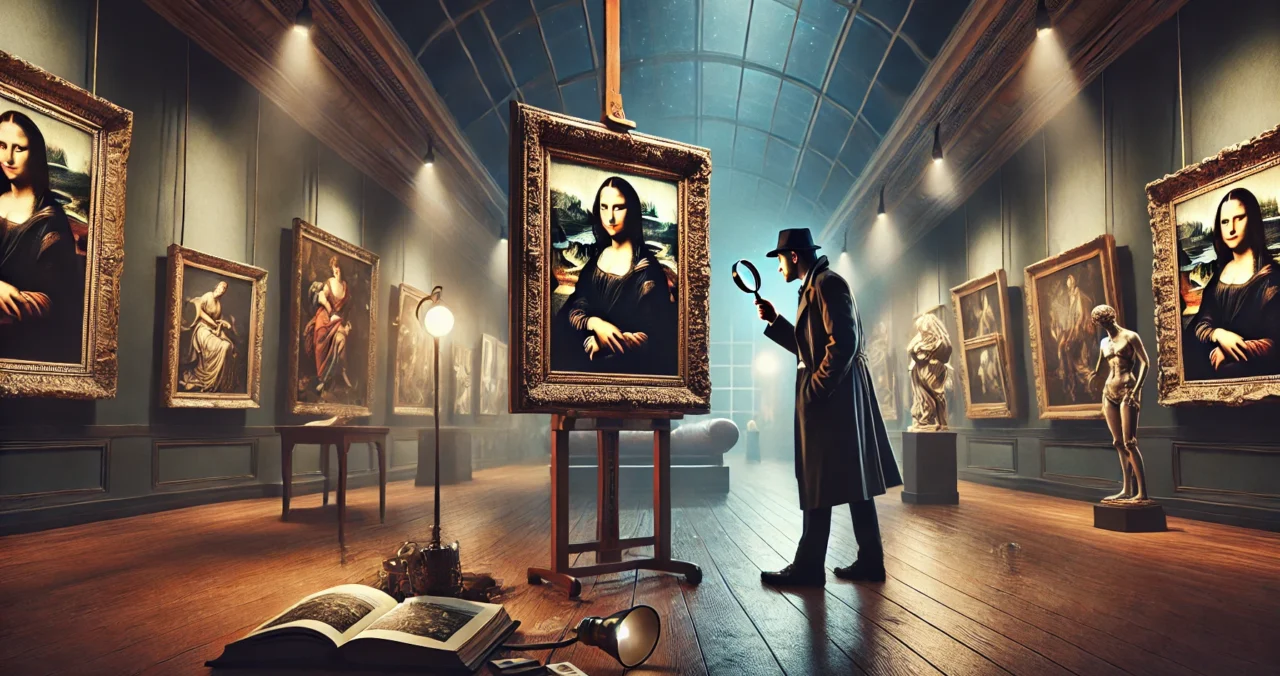Who Painted the Image Above: Your Ultimate Guide to Identifying the Artist

The question “who painted the image above” pops up frequently in classrooms, art galleries, online forums, and casual conversations among art enthusiasts. It’s a natural curiosity—when we encounter a striking painting, we want to know the creative mind behind it. Yet, without context, answering “who painted the image above” can feel like solving a mystery with missing clues. This article dives deep into the process of identifying the artist behind a painting, offering you a step-by-step toolkit to unravel the answer. From traditional techniques like analyzing signatures and styles to leveraging cutting-edge technology, we’ll cover it all. Whether you’re a student tackling an art history quiz, a collector eyeing a masterpiece, or just someone captivated by a random image, this guide will empower you to find out “who painted the image above” with confidence.
Why “Who Painted the Image Above” Matters
Before we explore how to answer “who painted the image above,” let’s consider why it’s worth asking. Knowing the artist transforms our experience of a painting. It connects us to their story, their era, and the cultural currents that shaped their work. A painting by Vincent van Gogh, with his swirling brushstrokes, tells a tale of passion and turmoil, while a serene landscape by Claude Monet whispers of light and nature’s fleeting beauty. Identifying “who painted the image above” also has practical stakes—artworks by famous artists can fetch millions at auction, while unsigned pieces might remain undervalued. Beyond value, it’s about appreciation: understanding the creator deepens our connection to the art.
Step 1: Look for the Obvious—Signatures and Labels
When pondering “who painted the image above,” the first place to look is the painting itself. Many artists sign their work, often in a corner or along an edge. These signatures can be a direct answer to “who painted the image above.” For instance, Picasso’s bold “Picasso” or Van Gogh’s looping “Vincent” are instantly recognizable. Some signatures are subtle—initials, monograms, or even hidden within the composition—so inspect closely. If you’re viewing a physical piece, check the back for labels, gallery tags, or handwritten notes, which might name the artist or provide provenance (ownership history). Online images might include captions or metadata revealing “who painted the image above,” so don’t skip the fine print.
Step 2: Analyze the Artistic Style
If no signature jumps out, the next clue to “who painted the image above” lies in the style. Every artist has a fingerprint—distinctive techniques, colors, or subjects that mark their work. Ask yourself: Does the image above feature vibrant, choppy brushstrokes like Van Gogh’s post-impressionism? Or soft, hazy light like Monet’s impressionism? Maybe it’s geometric and fragmented, hinting at Picasso’s cubism. Historical context helps too—Renaissance art often glows with realism (think Leonardo da Vinci), while Baroque works burst with drama (Caravaggio’s shadows). By matching the style to a movement or artist, you narrow down “who painted the image above.”
Examples of Styles to Recognize
- Impressionism: Loose brushwork, bright colors—Monet, Renoir.
- Expressionism: Emotional, distorted forms—Edvard Munch, Van Gogh.
- Surrealism: Dreamlike, bizarre scenes—Salvador Dalí, Max Ernst.
- Renaissance: Balanced, realistic—Da Vinci, Raphael.
Step 3: Consider the Subject Matter
The content of the painting can also whisper “who painted the image above.” Artists often gravitate toward signature themes. If the image above depicts a starry night or sunflowers, Van Gogh might spring to mind. Water lilies? Monet’s a strong contender. Religious scenes with chiaroscuro (light-dark contrast) could point to Caravaggio or Rembrandt. Portraits of royalty might suggest Diego Velázquez, while abstract shapes could scream Jackson Pollock. Jot down what you see—people, landscapes, objects—and cross-reference with famous works to guess “who painted the image above.”
Step 4: Dive Into Historical Context
Art doesn’t exist in a vacuum. To solve “who painted the image above,” consider when and where it might have been created. A painting with steam trains and smoky skies could hail from the Industrial Revolution, aligning with Monet’s “Gare Saint-Lazare.” Medieval religious panels might tie to Giotto or Duccio. The clothing, architecture, or technology depicted can pinpoint an era, narrowing the pool of artists. If the image above feels Romantic—wild nature, lone figures—Caspar David Friedrich’s “Wanderer Above the Sea of Fog” (1818) might be a clue. Historical sleuthing refines your answer to “who painted the image above.”
Step 5: Use Technology to Crack the Case
In 2025, technology is your ace in the hole for answering “who painted the image above.” Tools like Google Images or Google Lens let you upload a photo and search for matches across the web. Snap a picture of the image above, drag it into the search bar, and watch results roll in—often with artist names, titles, and sources. Apps like Smartify or platforms like Google Arts & Culture use AI to compare your image to vast databases, pinpointing “who painted the image above” in seconds. Social media, like X posts from art buffs, might also buzz with guesses—just don’t treat them as gospel without cross-checking.
Step 6: Consult Art Experts or Communities
Sometimes, “who painted the image above” needs a human touch. Art historians, curators, or appraisers can analyze brushwork, materials (e.g., oil on canvas), and provenance to name the artist. Online forums like Reddit’s r/Art or Quora often tackle “who painted the image above” queries—post a clear photo and details (size, medium, source) for crowd-sourced help. Museums or galleries might offer identification services too. Experts bridge gaps that tech or guesswork can’t, delivering a solid answer to “who painted the image above.”
Famous Examples: Solving “Who Painted the Image Above”
Let’s apply these steps to iconic works:
- “Mona Lisa”: Signature? None, but the realistic style, Renaissance vibe, and Louvre provenance scream Leonardo da Vinci.
- “Starry Night”: Swirling skies, vivid colors, and Van Gogh’s known mental state in 1889 point to him.
- “Guernica”: Cubist chaos, war themes, and Picasso’s 1937 context make it unmistakable.
If the image above resembles these, you’ve got a head start.
Challenges in Answering “Who Painted the Image Above”
Not every painting yields easily to “who painted the image above.” Unsigned works, copies, or forgeries muddy the waters. Students on platforms like Brainly often wrestle with vague quiz images—options like “Monet, Van Gogh, Renoir” test recognition skills. Lesser-known artists or damaged pieces complicate things further. If the image above lacks context (e.g., a screenshot sans caption), you’ll need patience and persistence to crack it.
Why Paintings Go Unidentified
- No Signature: Many old masters skipped signing.
- Lost Records: Wars or time erase provenance.
- Imitations: Students or followers mimic masters, blurring lines.
Practical Tips to Master “Who Painted the Image Above”
- Study Art History: Familiarize yourself with movements and artists.
- Practice Observation: Train your eye for style and detail.
- Keep a Reference List: Bookmark famous works and their creators.
- Leverage Tech: Use apps before guessing blindly.
- Ask Questions: Where did you see the image above? Context is king.
The Emotional Payoff of Knowing “Who Painted the Image Above”
Solving “who painted the image above” isn’t just academic—it’s personal. Imagine discovering the image above is a Frida Kahlo self-portrait, raw with pain and identity, or a Georgia O’Keeffe flower, bold and sensual. The artist’s name unlocks their world, making the painting a conversation across time. It’s a thrill worth chasing, whether for a grade, a collection, or pure joy.
Conclusion
“Who painted the image above” is more than a question—it’s an adventure. Start with the obvious: check for signatures or labels. Dig deeper with style, subject, and history. Tap into technology like Google Lens or expert wisdom to seal the deal. Each step brings you closer to naming the genius behind the canvas, turning a fleeting wonder into a lasting connection. The image above might be a Monet masterpiece, a Renaissance relic, or an unknown gem waiting to be claimed. Whatever it is, you now hold the tools to answer “who painted the image above” with authority. So, next time you’re stumped, don’t just stare—start sleuthing. The artist’s story is waiting to be told, and you’re the one to tell it.




